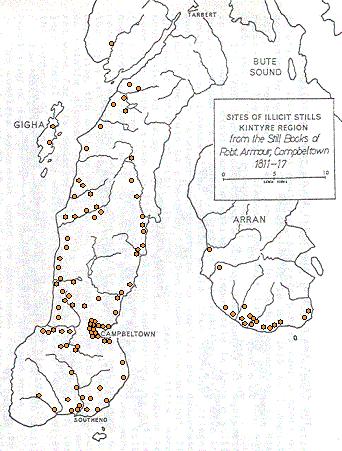When Mathew Spiers’ Lagg Distillery (located behind the Lagg Hotel at Kilmory) closed in 1837 it seemed that the last Arran water had been produced. Arran, like the neighbouring Kintyre peninsula, was famous for turning their local barley crop into whisky, which had a ready market across the Firth of Clyde in the rapidly expanding Glasgow. However the Factor for the Duke of Hamilton’s estate was under pressure from the excise to close the estimated 50 illicit stills on Arran which were providing a cut to the Duke’s pocket, as it was the quickest route for tenant farmers to turn a crop into cash. Three reasons are cited for the demise of Arran water, the explosive growth of distilling in Cambeltown, poor quality harvests on Arran and increased duty on imported Irish barley which made illicit distilling uneconomic.

The spark that grew to become the Isle of Arran Distillery at Lochranza was ignited at a the dinner of the Arran Society of Glasgow in 1991 when the retired managing director of Chivas Brothers Harold Currie and the architect David Hutchison met. The result was the first new C20 independent distillery in Scotland, which produced its first spirit on Thursday 29 June 1995. The distillery, designed by David Hutchison has an outwardly traditional appearance with whitewashed walls and slate roofs with copper pagodas at their peaks. However once inside, rather than a warren of small rooms, mashing, fermenting and distilling all take place within one large open space designed purposely to allow visitors to view the whole process. The mash tun is stainless steel but the four wash backs are traditional wooden vessels (three of Douglas fir and the fourth of Oregon pine). The stills are small (wash 7100 litres, spirit still 4300 litres) and of an onion design made by Forsyths. The Optic barley comes from Morayshire, malted by Bairds at Pencaitland in East Lothian, but the water is pure Arran.
Although a lot is made of Loch na Davie as the source of the water, in fact this spot is little more than a small marshy pool on the diffluence col between Glen Easan and Glen Iorsa. The River Easan draws its water from impermeable granite and glacial gravel and so is clear, clean and lacking in the peaty residues that characterises most other island whiskies.
The master distiller is George Mitchell who also oversaw the commissioning of Colleys Distillery in County Louth and is unique in being responsible for a gold medal winning Irish whiskey (Connemara 12 year old peated malt whiskey) and a Scottish whisky (10 years old non-chill filtered). And this year the distillery itself was awarded Distillery of the Year 2007 by Whisky magazine.